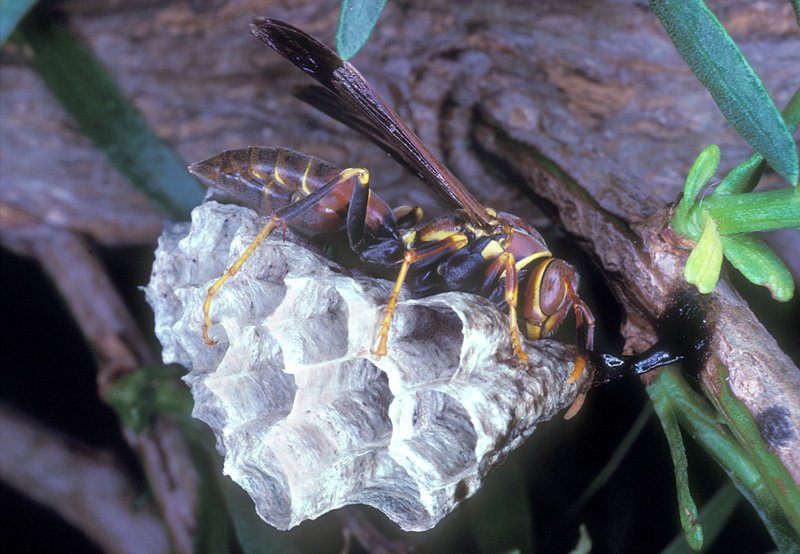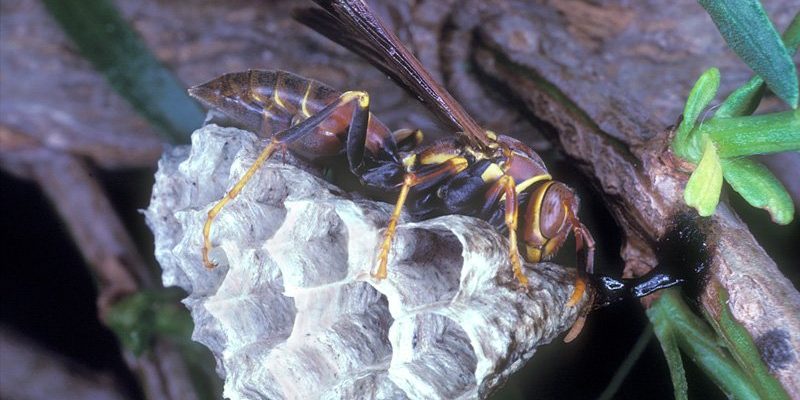
In this article, we’ll delve into the world of paper wasps, exploring the various predators and threats that make their lives a bit more precarious. Along the way, we’ll uncover what makes these wasps unique and why their survival matters to our environment. So, grab a cup of coffee, and let’s get into it!
Understanding Paper Wasps
Let’s start by painting a picture of what exactly a paper wasp is. These insects are typically identified by their long legs and slender waists. They craft nests using chewed wood fibers mixed with saliva, giving their homes, as the name suggests, a paper-like appearance. You can often find them hanging under eaves, decks, or trees, where they create tightly packed structures that host their colonies.
Paper wasps are not just builders; they’re also active hunters. They feast mostly on nectar and insects, which makes them valuable for controlling pests. Their diet plays an essential role in our gardens and natural habitats, as they help keep other insect populations in check. However, with their crucial role in the ecosystem comes the risk of predators that threaten their survival.
Key Predators of Paper Wasps
Now, let’s dive into the main players in the predator game. Several animals and insects have found paper wasps to be a delicious meal. Here are some of the top contenders:
- Birds: Many bird species, particularly those that feed on insects, see paper wasps as a tasty snack. Blue jays and sparrows are common culprits that hunt these wasps.
- Other Insects: Believe it or not, other wasps can be predators, too. For instance, some species of yellowjackets don’t hesitate to invade paper wasp nests for an easy meal.
- Mammals: Small mammals, including raccoons and rodents, may also raid nests for a protein boost. Their curiosity can lead them to spots where wasps are busy buzzing about.
Each of these predators poses unique challenges for the paper wasp. Birds, with their speed and agility, can swoop in before a wasp even knows what’s happening. Meanwhile, other wasps use sheer numbers to overpower paper wasps in a dramatic turn of events.
Environmental Threats to Paper Wasps
Besides predators, paper wasps also face numerous environmental threats. Let’s explore those factors:
Pesticides
The use of pesticides in gardens and agricultural areas can harm not just the targeted pests but also beneficial insects like paper wasps. When the chemicals spread, they can disrupt the delicate balance of the ecosystem, leading to declines in wasp populations. It’s like throwing a wrench in a well-oiled machine; everything starts to break down.
Habitat Loss
Human activities, such as urban development and deforestation, are creating significant habitat loss for paper wasps. As trees and natural spaces disappear, so do the nesting sites these wasps rely on. If they can’t find suitable locations to build their nests, their populations will dwindle. Imagine trying to find a home in a crowded city; it just becomes harder and harder.
Climate Change
We can’t ignore the impact of climate change. Shifting weather patterns can affect the availability of food and suitable nesting sites for paper wasps. For instance, unseasonably warm winters could lead to more wasps emerging too early when food sources aren’t ready. The result? A challenging situation for our winged friends.
Natural Defense Mechanisms of Paper Wasps
Now that we’ve talked about their threats, let’s consider how paper wasps defend themselves. These wasps have some interesting adaptations to help them survive:
- Stinging: The most common defense is, of course, their sting. When threatened, paper wasps can sting to protect themselves and their nests.
- Camouflage: Their nests often blend into their surroundings, making them less visible to predators. This natural camouflage can be a lifesaver.
- Group Defense: Paper wasps are social insects. They work together to defend their nests from intruders. This means one wasp’s alarm can signal many others to join in the defense.
These defense mechanisms are vital for their survival and highlight the resilience of these insects in the face of danger. Think of it like a well-organized team; they rely on each other to stay safe.
The Importance of Paper Wasps in Our Ecosystem
You might wonder why we should care about paper wasps and their struggles. These creatures play a crucial role in balancing our ecosystems. Here’s why:
- Pest Control: They feed on various insects, keeping pest populations in check. This can reduce the need for chemical pesticides, which is better for the environment.
- Pollination: Just like bees, paper wasps also contribute to pollination. By feeding on nectar, they help plants reproduce, which is essential for food production.
- Food Source: They serve as a food source for various animals, creating a link in the food web. Their extinction could impact many species that rely on them.
The presence of paper wasps indicates a healthy environment. Losing them could lead to unintended consequences that can ripple through ecosystems.
How to Help Paper Wasps Thrive
If you’re concerned about paper wasps and want to support their survival, there are steps you can take:
- Minimal Pesticide Use: Reduce or eliminate the use of pesticides in your garden. Consider organic alternatives that won’t harm beneficial insects.
- Preserve Natural Habitats: Support conservation efforts that protect natural habitats. The more natural space available, the better for paper wasps.
- Educate Others: Share what you learn about paper wasps. The more people understand their importance, the more they’ll want to protect them.
Even small actions can make a big difference in preserving these valuable insects and their ecosystems.
Paper wasps are often misunderstood and sometimes unfairly vilified. But when you take a moment to look closer, you’ll see that they are crucial players in maintaining a balanced ecosystem. From their role as pest controllers to their contributions to pollination, they deserve our respect and protection. While they face challenges from predators, environmental changes, and human activity, recognizing their importance can help ensure their survival.
Next time you see a paper wasp, remember the battles they face. You might just look at them with a bit more appreciation. By understanding their struggles and taking steps to help, we can all play a part in supporting these incredible insects.

